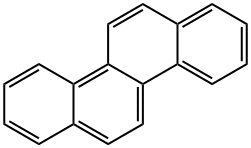Chrysene , 97% , 218-01-9
Synonym(s):
Chrysene
CAS NO.:218-01-9
Empirical Formula: C18H12
Molecular Weight: 228.29
MDL number: MFCD00003698
EINECS: 205-923-4
| Pack Size | Price | Stock | Quantity |
| 100mg | RMB105.60 | In Stock |
|
| 250MG | RMB191.20 | In Stock |
|
| 1G | RMB484.80 | In Stock |
|
| 5G | RMB2112.80 | In Stock |
|
| others | Enquire |
PRODUCT Properties
| Melting point: | 252-254 °C (lit.) |
| Boiling point: | 448 °C (lit.) |
| Density | 1.274 |
| vapor pressure | 4.3 at 25 °C (de Kruif, 1980) |
| refractive index | 1.7480 (estimate) |
| Flash point: | -17℃ |
| storage temp. | Store below +30°C. |
| solubility | <0.0001g/l |
| form | solid |
| color | White to Light yellow to Light orange |
| Water Solubility | insoluble |
| Merck | 14,2255 |
| BRN | 1909297 |
| Henry's Law Constant | 1.97, 6.91, 18.8, 52.3, and 118 at 4.1, 11.0, 18.0, 25.0, and 31.0 °C, respectively (Bamford et al.,
1998) |
| Stability: | Stable. Combustible. Incompatible with strong oxidizing agents. |
| InChIKey | WDECIBYCCFPHNR-UHFFFAOYSA-N |
| CAS DataBase Reference | 218-01-9(CAS DataBase Reference) |
| NIST Chemistry Reference | Chrysene(218-01-9) |
| IARC | 2B (Vol. 92) 2010 |
| EPA Substance Registry System | Chrysene (218-01-9) |
Description and Uses
Chrysene is a polycyclic aromatic hydrocarbon (PAH) with the molecular formula C18H12. It is one of the natural constituents in coal tar, from which it was first isolated and characterized. It is produced as a gas during combustion of coal, gasoline, garbage, animal, and plant materials and usually found in smoke and soot. Chrysene usually combines with dust particles in the air and is carried into water and soil and onto crops. Creosote, a chemical used to preserve wood contains chrysene. High concentration of chrysene in the air is typically found during open burning and home heating with wood and coal. People are exposed to chrysene from a variety of environmental sources such as air, water, and soil and from cigarette smoke and cooked food. General population is usually exposed to chrysene along with a mixture of similar chemicals. Chrysene is a by-product of many industrial processes and thereby released in the atmosphere. Chrysene is lipophilic, insoluble in water, slightly soluble in other polar solvents such as alcohol, ether and moderately soluble in benzene and toluene. However, it readily dissolves in benzene and toluene at an elevated temperature. The name ‘Chrysene’ originates from the Greek word chrysos, meaning ‘gold,’ and is due to the golden yellow color of the slightly impure crystals. However, in pure state, chrysene is a colorless, crystalline solid. It has characteristic red–blue fluorescence under UV light. Some important properties of chrysene are summarized below.
Used strictly for research purposes.
Safety
| Symbol(GHS) |   GHS08,GHS09 |
| Signal word | Danger |
| Hazard statements | H341-H350-H410 |
| Precautionary statements | P201-P273-P308+P313 |
| Hazard Codes | T,N,Xn,F |
| Risk Statements | 45-50/53-68-40-67-66-36-11-52/53-36/37/38 |
| Safety Statements | 53-45-60-61-36/37-26-16-24/25-23 |
| RIDADR | UN 3077 9/PG 3 |
| WGK Germany | 3 |
| RTECS | GC0700000 |
| HazardClass | 9 |
| PackingGroup | III |
| HS Code | 29029090 |
| Hazardous Substances Data | 218-01-9(Hazardous Substances Data) |
| Toxicity | Acute LC50 for Neanthes arenaceodentata >50 μg/L (Rossi and Neff, 1978). |
| Limited Quantities | 5.0 L (1.3 gallons) (liquid) or 5.0 kg (11 lbs) (solid) |
| Excepted Quantities | Max Inner Pack (30g or 30ml) and Max Outer Pack (1Kg or 1L) |




